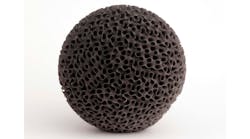This article is part of our IMS2022 coverage.
Rogers Corporation will be in Booth #2030 at IMS showing products that include the company’s Radix 3D-printable dielectrics and RO4835IND LoPro laminates. Radix 3D-printable dielectric is claimed as the first 3D material featuring a dielectric constant of 2.8 and low loss characteristics at microwave frequencies. These printable dielectric materials give RF designers great design freedom in creating new components, eliminating the need to consider typical manufacturing design constraints.
Rogers Corporation’s Radix 3D-printable dielectric is a proprietary composite material designed for Digital Light Processing (DLP) 3D printing, enabling a scalable, high-resolution printing process for end-use RF dielectric component manufacturing. This printable dielectric material has a targeted dielectric constant of 2.8 and a dissipation factor of 0.0043 at 10 GHz when cured.
The new material is intended for use as RF material in applications where new geometric freedom can enhance the figure of merits of an RF system, such as gradient dielectric constant (GRIN) structures and other complex three-dimensional parts. The Radix 3D Printable Dielectric offers the industry a way to manufacture systems and components at scale that could not be made with traditional fabrication methods. Radix materials are available directly from Rogers Corporation and its 3D-printing partners.
RO4835IND LoPro thermoset laminates are specially designed for 60-to-81-GHz, short-range industrial radar applications, in which excellent electrical performance and cost efficiency are equally important. These laminates also provide environmental reliability and interconnection stability, which are critical criteria for PCB material selection.
With a low insertion loss of 2.13 dB/inch at 60 GHz, these laminates meet customers’ critical radar-coverage requirements. The expanded-weave fiber provides excellent Dk uniformity, and Rogers’ tight quality control provides low Dk variation from lot to lot. RO4835IND LoPro laminates are compatible with standard epoxy/glass (FR-4) processes and have a higher fabrication yield rate compared to conventional PTFE-based laminates. Low material and fabrication costs make RO4835IND LoPro laminates a cost-effective solution for industrial radar.
In addition, Rogers’ Technical Marketing Manager, John Coonrod, will give three presentations on June 21st in the MicroApps Theater at IMS. Topics will include “Radix 3D Printable Dielectrics & Lens Demonstrator,” “An Overview of Copper Foil: How It's Made, Roughness Effects & RF/ HSD Influences,” and “How to Get Consistent Millimeter-Wave Performance Using Grounded Coplanar Waveguide.”
For more information, visit the company website.
For more IMS2022 coverage, visit our digital magazine.
